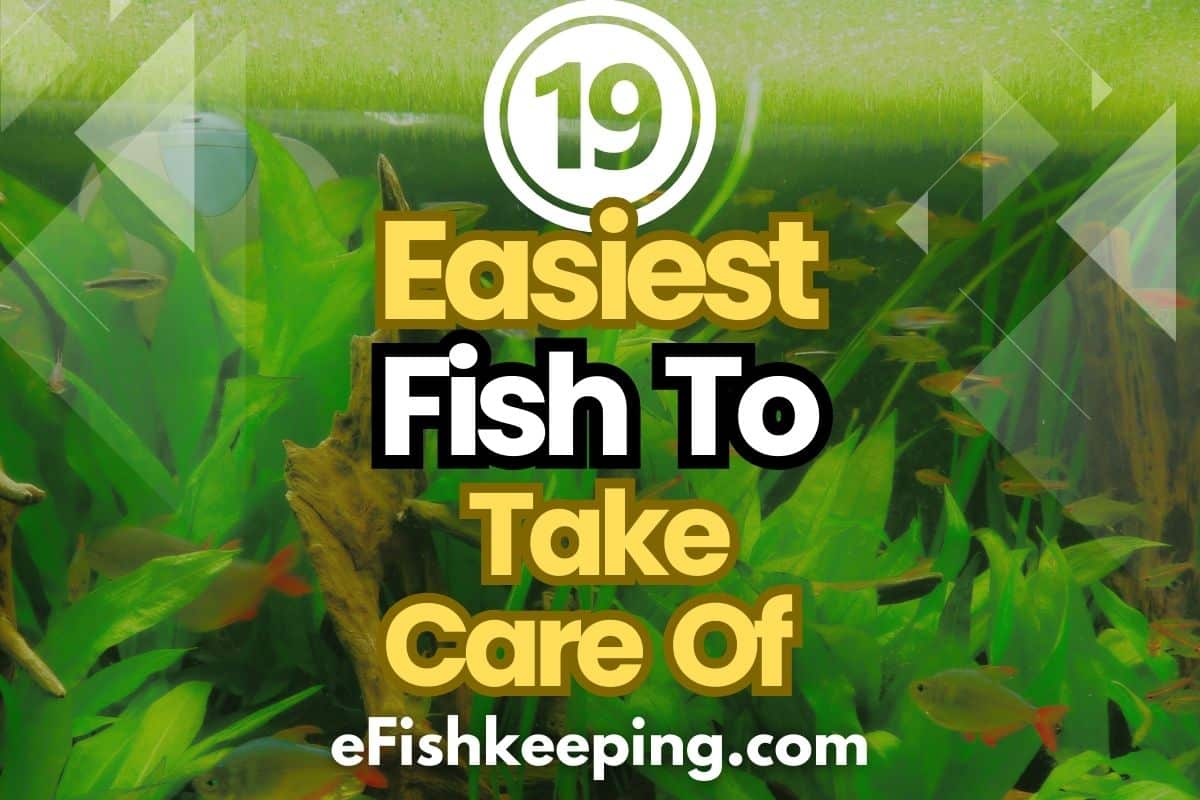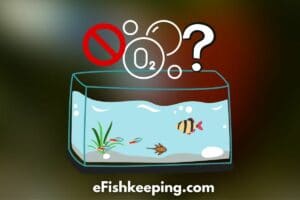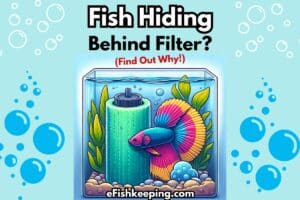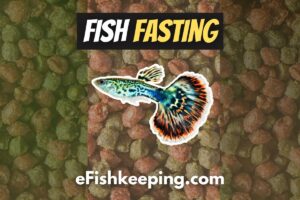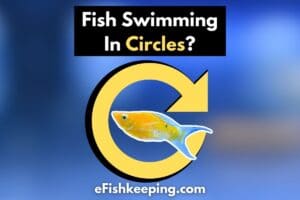Don’t have time for a high-maintenance aquarium?
Then this guide is for you.
Here are 19 Gorgeous aquarium fish that are hardy and are easiest to take care of. Make sure to read till the end to learn more about each one of them.
But first let’s understand what characteristics qualify a fish as a low-maintenance fish.
How To Know If A Fish Is Easy To Take Care For?
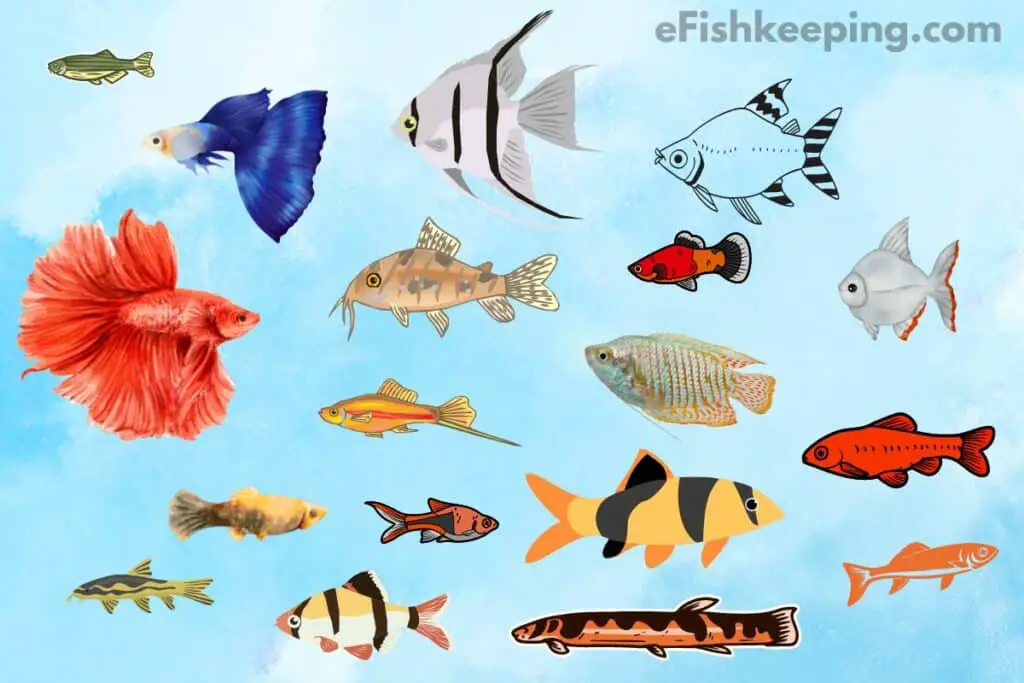
- They produce less waste – less waste, means less frequent water changes. Fish like bettas, or zebra danios produce less waste than a Goldfish.
- They are hardy species that can tolerate some variability in water parameters. For instance, Guppies (6.8 to 7.8 pH) and Mollies (7.5 to 8.5 pH). Look for fish that are flexible across a range of pH, temperature, and water hardness so that they have some wiggle room if conditions fluctuate slightly
- They are omnivorous and will eat most commercially available foods like flakes, pellets, frozen, or freeze-dried options. Species like guppies, mollies, and platies are not picky and will accept a variety of foods.
- They are peaceful community fish that coexist well with other species. Tetras, rasboras, , cory catfish are fish that focus on each other rather than disturbing other tank mates. Having multiple peaceful species allows for greater variety and interest in the aquarium.
- They stay relatively small, under 3-5 inches in length. Small fish like neon tetras, guppies, and dwarf cichlids require less tank space per individual than large fish, so you don’t need a huge tank setup to take care of them.
Note: You don’t need every fish to hit all these markers. But trying to find ones that check off as many as possible will make your life easier.
For instance, angelfish are easy to care for. However, they are a bit bigger in size and you have to be a bit careful about their tank mate choice. But still, they are pretty hardy and cheerful fish suitable for beginners. So the goal is to find that perfect balance.
Checklist Of Basic Requirement That All Aquarium Fish Need
Regardless of the type of fish you choose to keep, here are some basic requirements you need to consider to make sure they live happily in the tank.
- A cycled fish tank
- Water changes (every 15 days or 1 month)
- A good quality aquarium filter
- A heater
- Proper food at least once daily
The 19 Easiest And Low-Maintenance Fish For Aquarium
#1. Zebra Danio

Scientific Name: Danio rerio | Adult Size: 2 inches | Tank Size: 10 Gallons | Temperament: Peaceful And Active | Temperature: 64 – 74 °F (18 – 24°C) | Water Hardness: 5-12 dGH | pH: 6.5 – 7.0 | Care: Very Easy | Diet: Omnivore
These are my #1 favorite freshwater fish. And I highly recommend them because they are super hardy.
Put a bunch of them in a fish tank, and you’re good to go.
Then just feed them regularly and do water changes every two weeks or months, they’ll be fine.
Plus, the best thing is, I like their temperament and active nature. They add color and liveliness to any fish tank. Hands down they are the best, most easy to care for fish in the hobby!
#2. Guppies
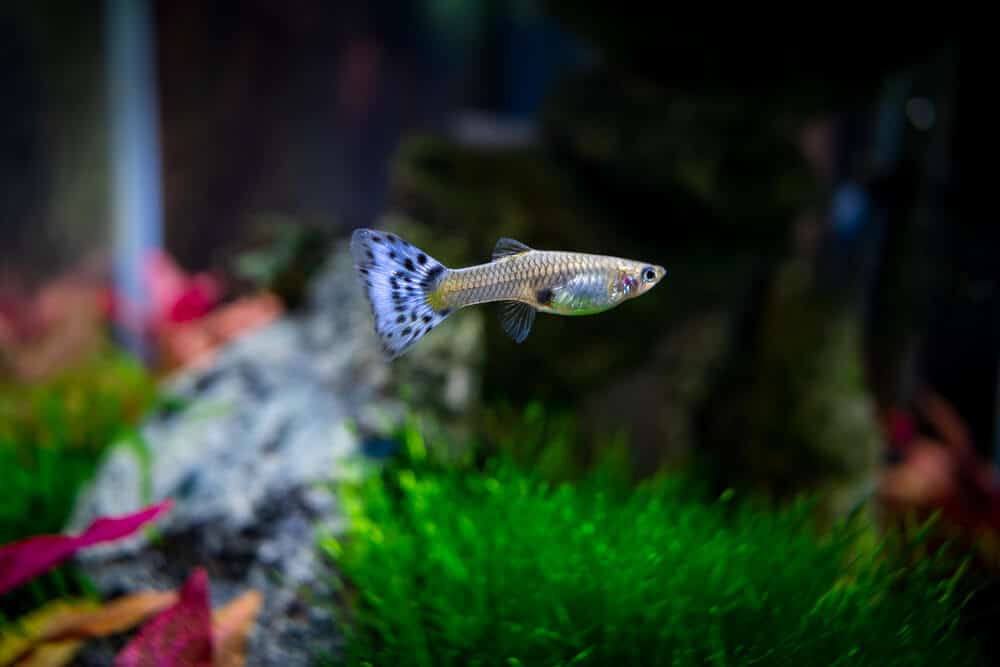
Scientific Name: Poecilia reticulata | Adult Size: 2 inches | Tank Size: 10 Gallons | Temperament: Peaceful And Active | Temperature: 68 – 78 °F (20 – 26°C) | Water Hardness: 6-8 dGH | pH: 6.5 – 8.0 | Care: Very Easy | Diet: Omnivore
Guppies are hardy fish and they don’t produce a lot of waste. Plus, they are small sized fish so you don’t have a huge tank setup to keep them – perfect for first-time fishkeepers.
They do well in planted tanks, but will do well in any fish tank setup. Even if you forget water changes once in a while, they are hardy enough to survive those minor errors.
#3. Cory Catfish
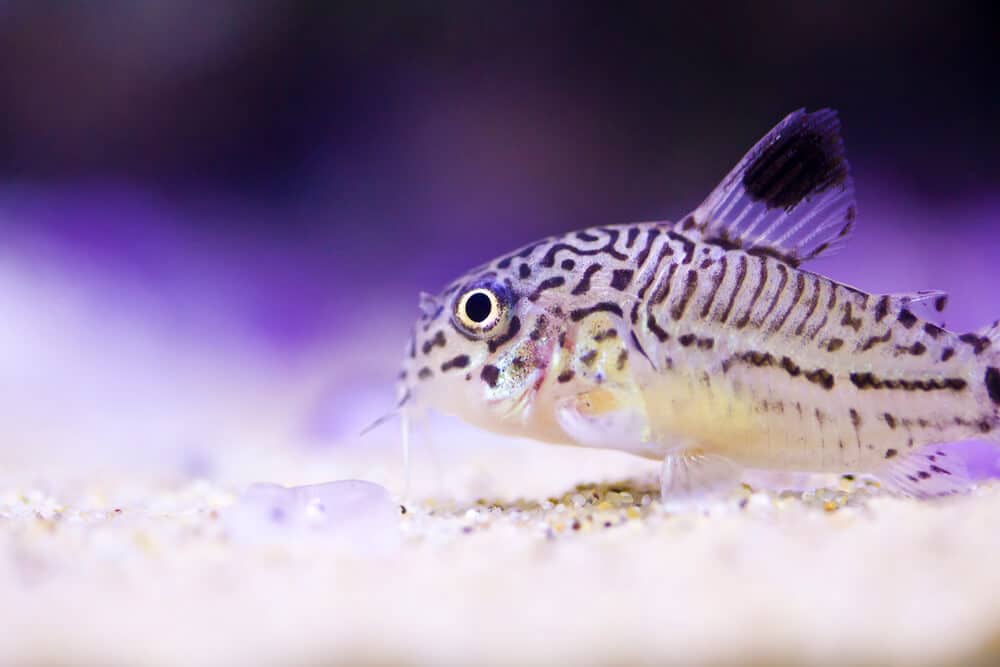
Scientific Name: Corydoras paleatus | Adult Size: 1–4 inches | Tank Size: 10 Gallons | Temperament: Peaceful And Active | Temperature: 70 – 78 °F (21 – 25.5°C) | Water Hardness: 5-10 dGH | pH: 5.5 – 7.0 | Care: Easy | Diet: Omnivore
Cory catfish are fun, peaceful bottom dwellers that are great for beginners. They are hardy fish that can tolerate a range of water conditions. They stay small, under 3 inches, so don’t need a huge tank. A 20 gallon tank is sufficient.
Cories are social and should be kept in groups of 6 or more. They primarily eat sinking pellets or wafers that are easy to feed. While they enjoy planted tanks, they do fine in simple setups too.
Since cories stay towards the bottom and aren’t aggressive, they mix well with other peaceful fish. Their active nature and cute behaviors like schooling together make them enjoyable to watch. Just be sure not to put them in a tank with aggressive fish that may nip at them.
#4. Mollies
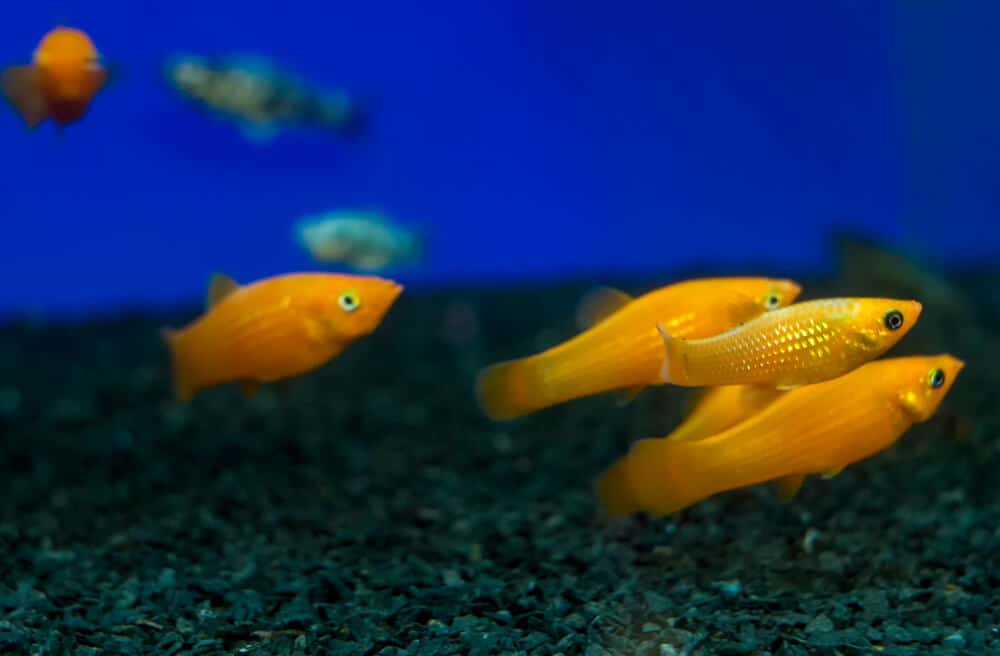
Scientific Name: Danio rerio | Adult Size: 3-5 inches | Tank Size: 20 Gallons | Temperament: Peaceful And Active | Temperature: 75 – 80 °F (24 – 27°C) | Water Hardness: 15-30 dGH | pH: 7.5 – 8.5 | Care: Easy | Diet: Omnivore
Mollies are a great starter fish for beginners. They are very hardy and can tolerate a wide range of water conditions, so you don’t have to be super meticulous with water changes and tank maintenance.
Mollies are omnivores and will eat both flakes and pellets, as well as any algae in the tank, making feeding easy. They stay small, usually under 4 inches, so they don’t need a massive tank.
Just a 10-20 gallon tank with some hiding spots will do. Mollies are peaceful community fish, so they get along well with other calm tankmates. Their lively nature makes them fun to watch.
#5. Bettas
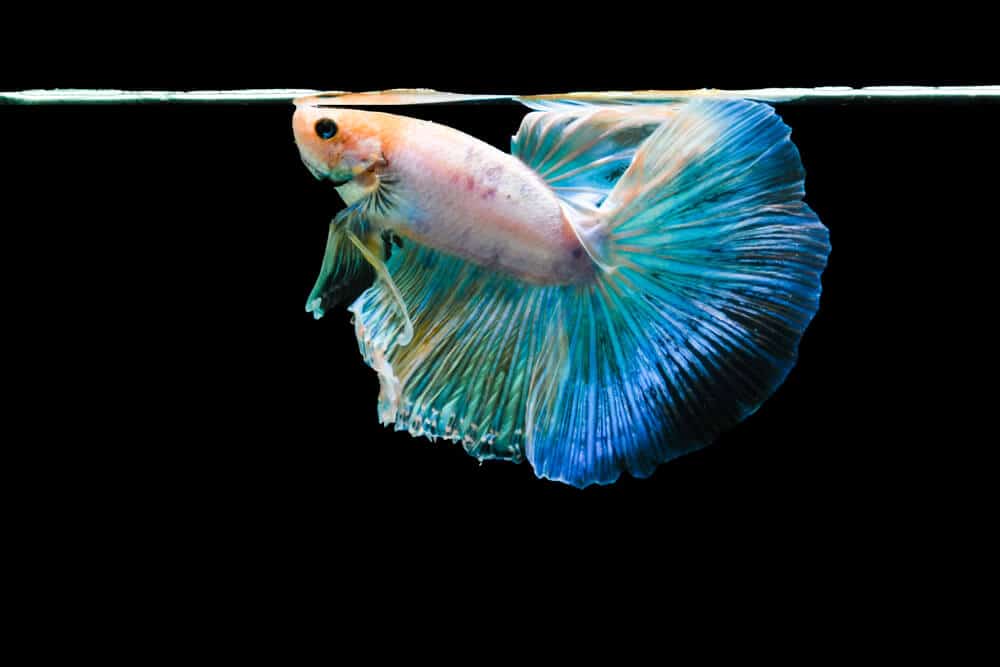
Scientific Name: Betta splendens | Adult Size: 3 inches | Tank Size: 5 Gallons | Temperament: Aggressive with other male bettas | Temperature: 75 – 86 °F (24 – 30°C) | Water Hardness: 5-20 dGH | pH: 6.8 – 7.4 | Care: Easy | Diet: Omnivore
Bettas are very easy fish to care for. They are hardy and don’t require much space, as they can live happily in a 5 gallon tank with a heater and filter.
They do well in planted tanks but simple setups work too. Bettas eat readily available betta pellets or flakes. While they tend to be aggressive towards other male bettas, they generally get along with calm tankmates like tetras or snails.
One thing to remember is that bettas need warmer water around 75-86 degrees Fahrenheit.
As long as you keep their water warm and clean, bettas are very low maintenance. Their beautiful fins and interactive nature make bettas a joy to have.
#6. Platies

Scientific Name: Xiphophorus maculatus | Adult Size: 3 inches | Tank Size: 10 Gallons | Temperament: Peaceful And Active | Temperature: 70 – 77 °F (21 – 25°C) | Water Hardness: 10-28 dGH | pH: 6.8 – 8.0 | Care: Easy | Diet: Omnivore
Platies are a great starter fish as they are very low maintenance and hardy. Staying under 3 inches, a 10 gallon tank is enough for a small group. They aren’t fussy about water conditions and can handle some neglect in their care.
Platies are omnivores and will accept most flakes or pellets offered. With their wide variety of colors and patterns, platies provide lots of visual interest. Combine that with their peaceful temperament toward other fish, and they are excellent for community aquariums.
Breeding platies is also easy, so you may soon have babies in your tank! All in all, platies are hardy, colorful, and easy fish that are ideal for new hobbyists.
#7. Harlequin Rasboras
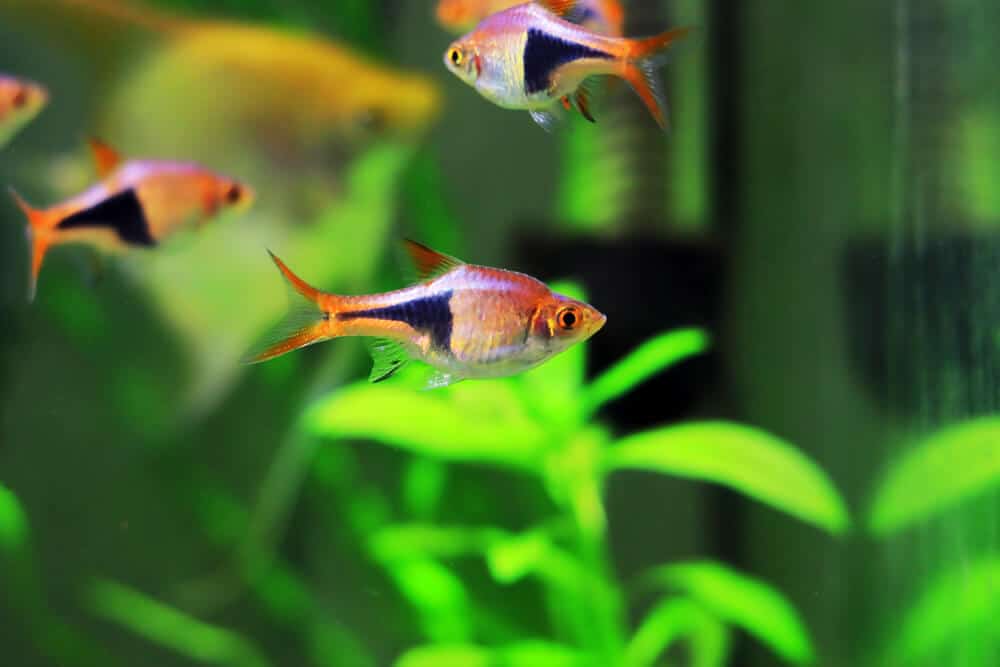
Scientific Name: Trigonostigma heteromorpha | Adult Size: 1.75 inches | Tank Size: 10 Gallons | Temperament: Peaceful And Active | Temperature: 73 – 82 °F (23 – 28°C) | Water Hardness: 2-15 dGH | pH: 6.0 – 7.5 | Care: Easy | Diet: Omnivore
Harlequin Rasboras are super hardy and can adapt to a wide range of water conditions. They don’t produce much waste, so you can be a bit more relaxed with water changes. Just feed them a basic flake or pellet food once or twice a day.
They’re also quite active and school together beautifully, adding lots of color and motion to your tank. A 10-gallon planted tank is perfect for a school of harlequins.
With their relaxed temperament, they mix well with other peaceful community fish too.
#8. Swordtails
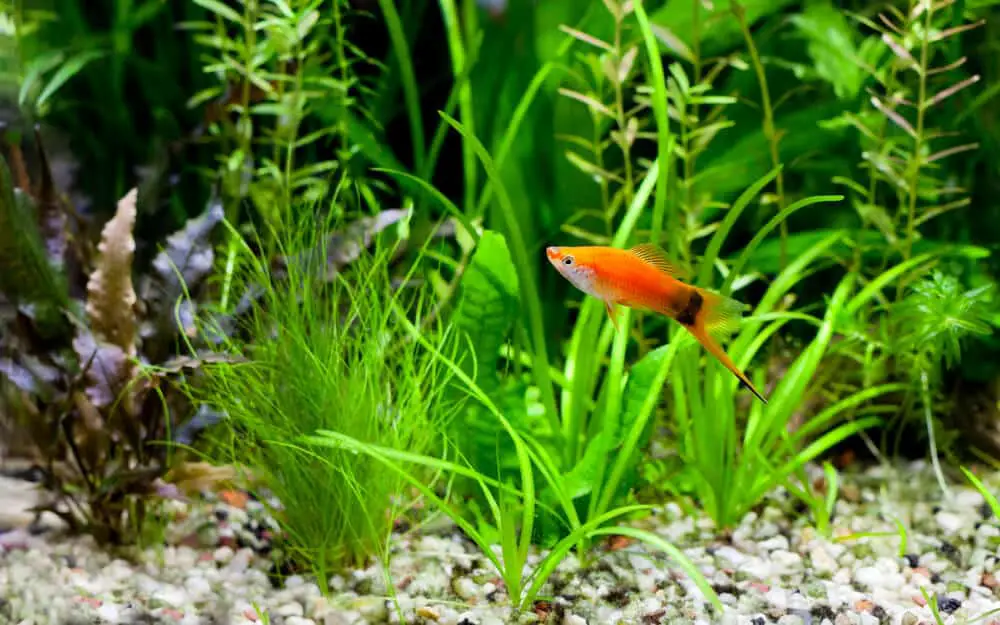
Scientific Name: Xiphophorus helleri | Adult Size: 4 inches | Tank Size: 20 Gallons | Temperament: Peaceful And Active | Temperature: 64 – 82 °F (18 – 28°C) | Water Hardness: 12-30 dGH | pH: 7.0 – 8.5 | Care: Easy | Diet: Omnivore
You can’t go wrong with easygoing swordtails. They are very hardy fish that can tolerate a range of water parameters, which makes things easier on you. Swordtails have a very small bioload, so they won’t dirty the water too quickly.
I recommend feeding them basic flake or pellet food once or twice a day. They aren’t picky! Swordtails are social and do best kept in groups. A 20-gallon tank with lots of plants is ideal, but they can work in 10 gallons too.
Given their peaceful temperament, swordtails pair nicely with lots of other community species. Their vibrant colors and flowing fins will liven up any aquarium. Go with swordtails if you want a low-maintenance tank with a splash of color!
#9. Otocinclus Catfish
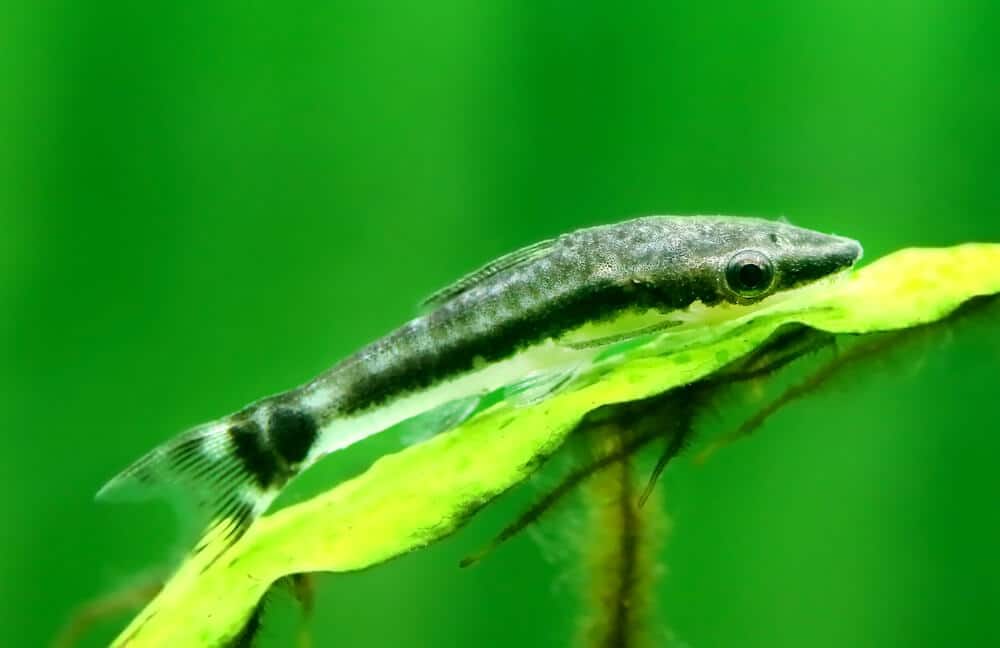
Scientific Name: O. vittatus | Adult Size: 1-2 inches | Tank Size: 10 Gallons | Temperament: Peaceful And Active | Temperature: 72 – 79 °F (22 – 26°C) | Water Hardness: 7-15 dGH | pH: 6.8 – 7.5 | Care: Easy | Diet: Herbivore
The Otocinclus Catfish are little algae eaters that are super hardy and undemanding. As long as you provide some algae wafers or blanched veggies, they will live happily in the tank.
The best part is they help clean up any extra algae in your tank, saving you work up to some extent! (Interested in keeping fish like Otos that help in tank cleaning? Then check out some of the best glass cleaner fish for aquariums here.)
Their tiny size and peaceful temperament means you can keep otos in virtually any sized community tank. They only produce a small amount of waste so water changes aren’t a big deal. I recommend groups of 3 or more otos since they’re social.
With their energetic movements and cute appearance, otos make great additions to planted tanks.
#10. Tiger Barbs
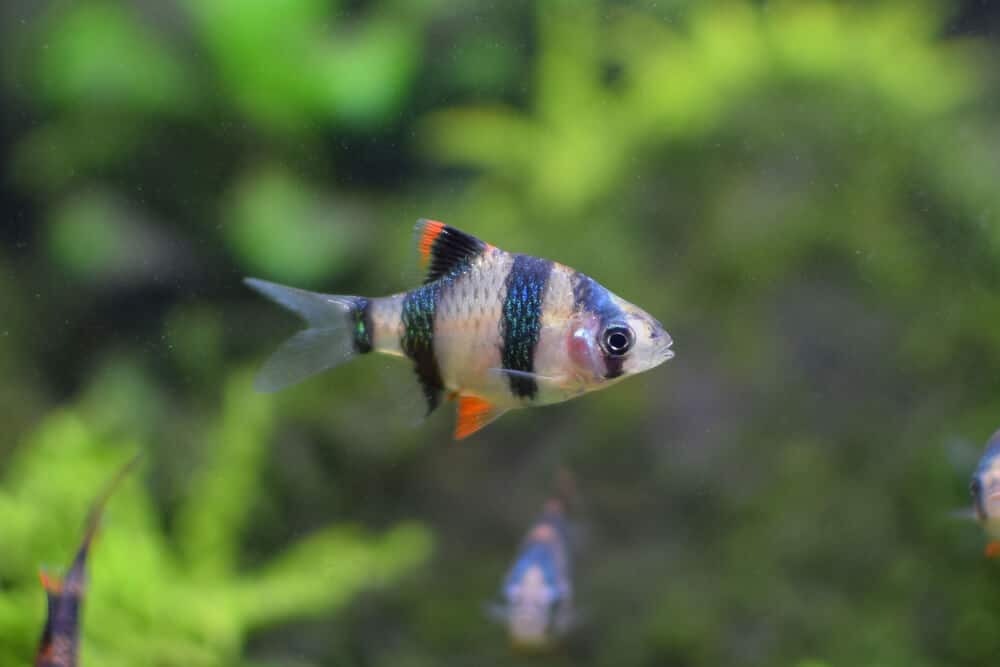
Scientific Name: Barbus tetrazona | Adult Size: 3 inches | Tank Size: 20 Gallons | Temperament: Active & Fin Nipping | Temperature: 68 – 79 °F (20 – 26°C) | Water Hardness: 5-19 dGH | pH: 6.0 – 7.5 | Care: Easy | Diet: Omnivore
Lively tiger barbs are a great option for new fishkeepers. They are very affordable, extremely hardy, and adapt well to a range of water conditions.
They aren’t picky eaters and will readily accept basic flakes or pellets. Tiger barbs do best in groups, so I recommend 6 or more for an active school. They can be kept in a 20 gallon tank or larger.
The one thing with tiger barbs is they can get nippy with tank mates who have long, flowing fins. Keeping them with other fast and active fish like cherry barbs, platies, or mollies is a good idea. I like tiger barbs because they add a lot of color and activity to any fish tank.
#11. Flagtail Fish
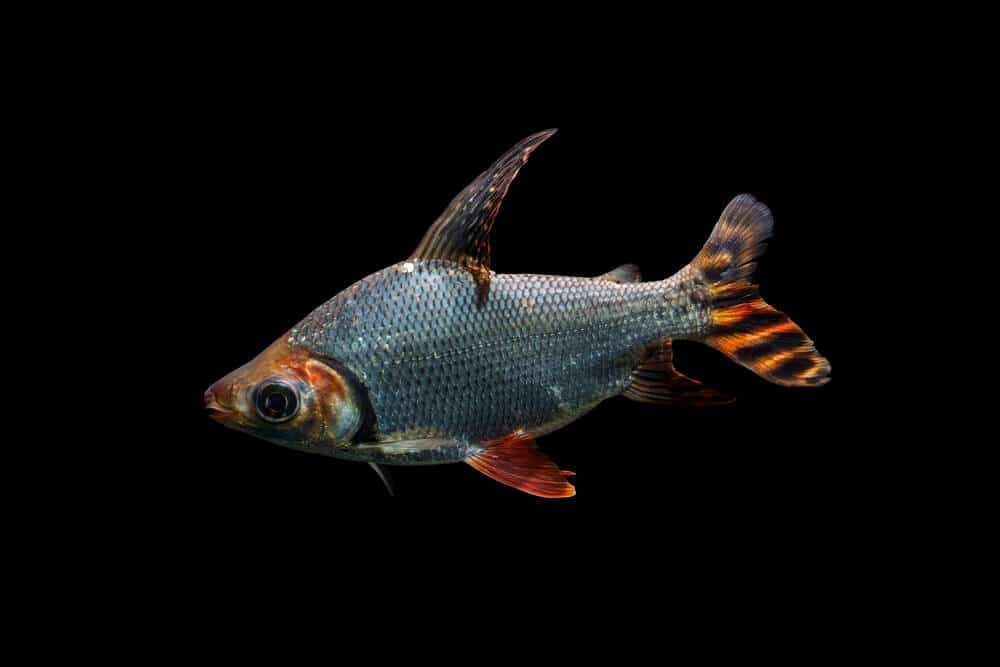
Scientific Name: Semaprochilodus taeniurus | Adult Size: 12 inches | Tank Size: 10 Gallons | Temperament: Peaceful And Active | Temperature: 64 – 74 °F (18 – 24°C) | Water Hardness: 5-12 dGH | pH: 5.5 – 7.5 | Care: Very Easy | Diet: Omnivore (but mainly Herbivore)
If you’re looking for an easy to take care of yet superb algae eater fish – then look no further than Flagtail fish.
Although they can grow up to 10-12 inches in size, you can keep young flagtail fish that are available in much smaller sizes (3-4 inches). A 55+ gallon tank is a good starting point to keep these fish.
Flagtail fish aren’t picky eaters at all. Just give them a basic small-grain flake or pellet food once or twice a day. Since they produce such a small bioload, infrequent water changes are no problem.
Their most striking feature is their large, colorful tail fins flowing behind them. I like their relaxed temperament and that’s why I recommend them for any big community tank setup.
By the way, did you know that larger fish tanks are easier to maintain compared to small fish tanks? Sounds interesting, right?
In short, it’s because of the higher water volume and dilution of harmful nutrients that occurs as a result. In other words, you can get away with less frequent water changes in a big fish tank. So if you have the budget, don’t hesitate to invest in a big fish tank setup.
#12. Gourami
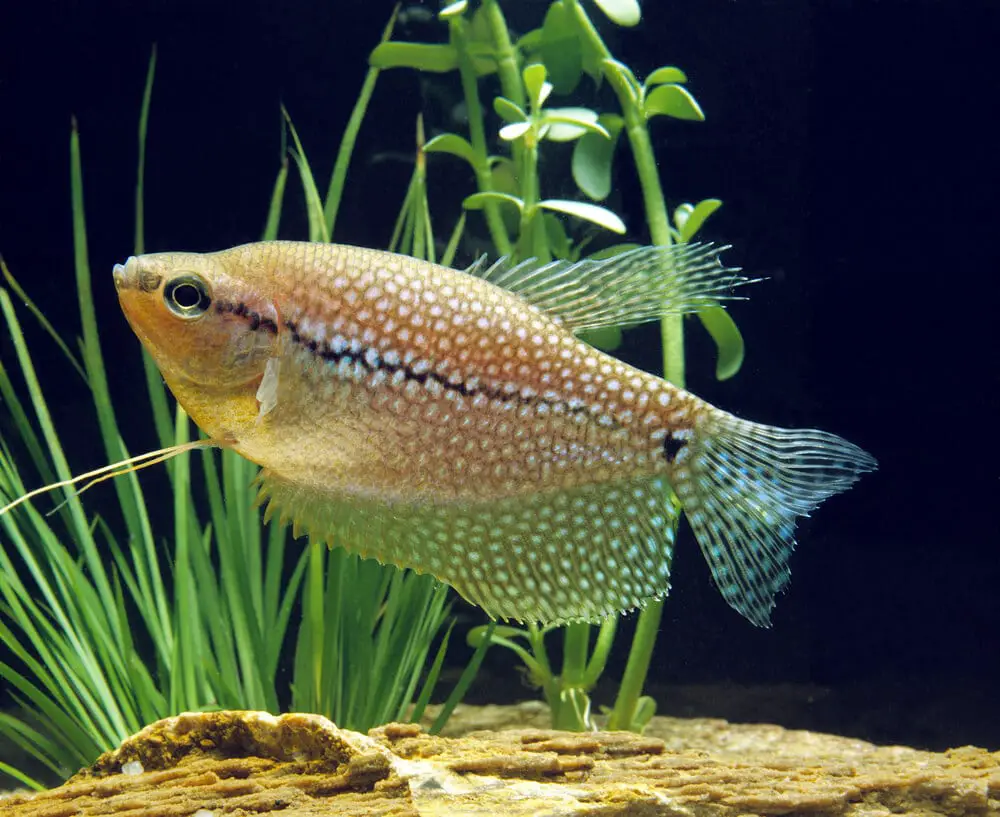
Scientific Family: Osphronemidae | Adult Size: 3-28 inches | Tank Size: 10 Gallons | Temperament: Peaceful And Active | Temperature: 75 – 80 °F (23.8 – 26.6°C) | Water Hardness: 4-15 dGH | pH: 6.8 – 7.8 | Care: Easy | Diet: Omnivore
Gouramis are a hardy fish that are easy to care for. Many varieties like the pearl gourami stay under 4-5 inches, so a 10+ gallon tank is sufficient. They can tolerate a range of water conditions and aren’t too picky about water changes.
Gouramis are omnivores and will accept most flakes, pellets or freeze dried foods readily. While aggressive toward each other, most gouramis get along well with other peaceful community fish.
Their unique shape and coloring makes them interesting to watch. Dwarf gouramis add a pop of color with their bright red or blue hues. Larger pearl gouramis have an elegant appearance.
There are many different gourami types you can go with like the Honey Gourami (2.5 inches), Chocolate Gourami (2 inches) or the Sparkling Gourami (1.5 inches).
#13. Kuhli Loach
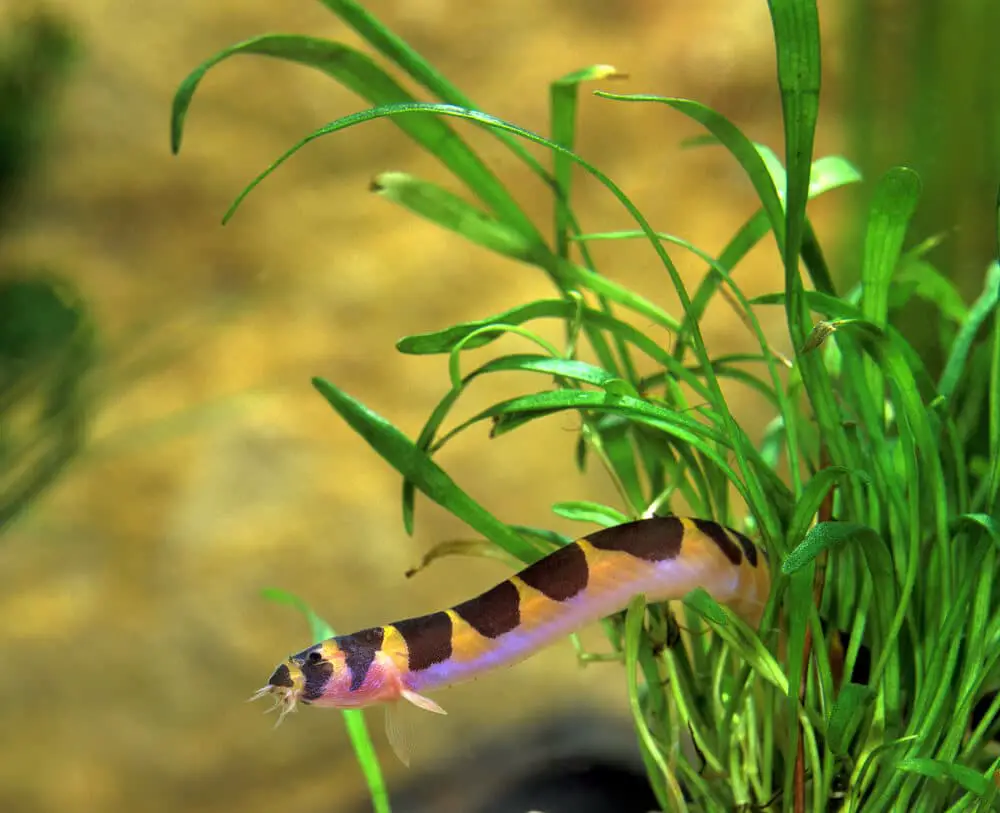
Scientific Name: Pangio kuhlii | Adult Size: 3-4 inches | Tank Size: 20 Gallons | Temperament: Peaceful | Temperature: 73 – 86 °F (23 – 30°C) | Water Hardness: 0-5 dGH | pH: 5.5 – 6.5 | Care: Easy | Diet: Omnivore
If you’re looking for a fish that attracts everyone’s attention, the Kuhli loaches are the perfect fish for you.
Their eel-like slender body with yellow and black stripes is worth a watch. Plus, these bottom-dwellers are extremely hardy and undemanding.
Kuhlis only get 3-4 inches long, so they don’t need a massive tank. A 20 gallon or larger community tank is perfect. They do well with the most peaceful fish. When it comes to food, kuhlis aren’t picky at all – they’ll accept basic flakes, pellets or bottom feeder tablets.
You’ll love their intriguing pattern and watching them wiggle around tank decorations. Kuhli loaches add lots of activity to the lower tank levels.
#14. Cherry Barb
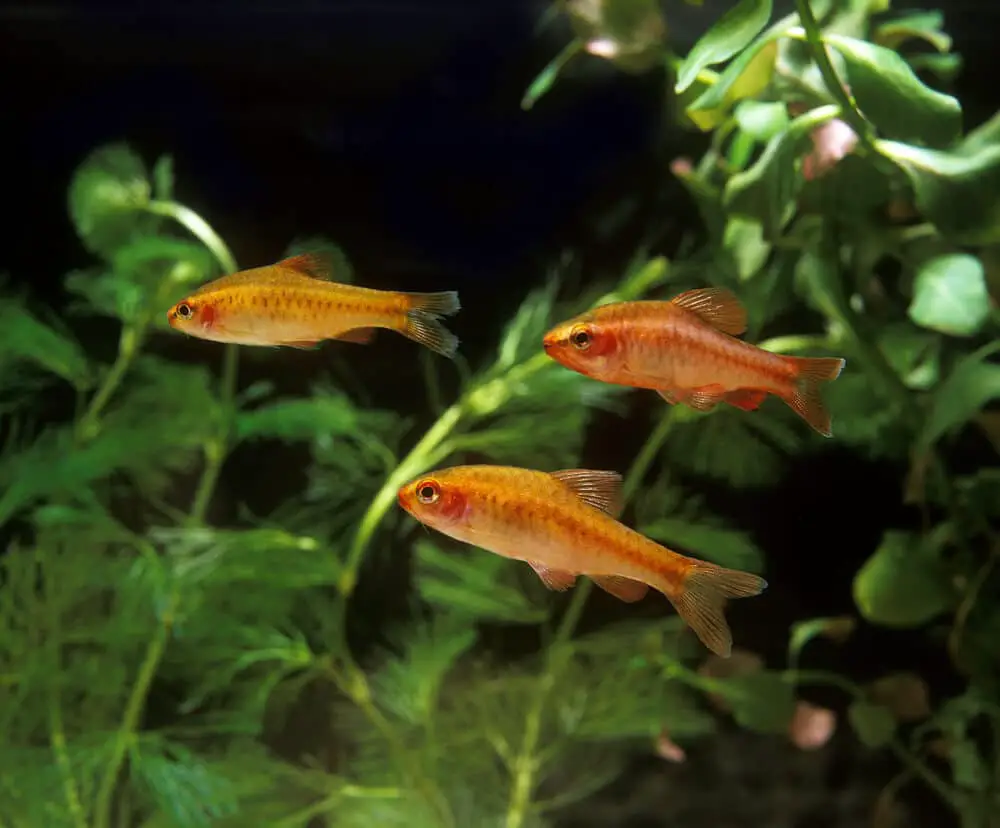
Scientific Name: Puntius titteya | Adult Size: 2 inches | Tank Size: 20 Gallons | Temperament: Peaceful And Active | Temperature: 74 – 79 °F (23 – 27°C) | Water Hardness: 4-10 dGH | pH: 6.0 – 7.0 | Care: Easy | Diet: Omnivore
Cherry Barbs are very affordable, extremely hardy, and adapt to a wide range of water conditions – perfect for beginners!
I recommend keeping them in schools of 6 or more. A 20 gallon tank is ideal for an active cherry barb school. Since they’re peaceful, they mix well with other community fish.
Their bright red color really pops against planted backdrops. Cherry barbs bring nonstop energy and color to a tank, with minimal effort on your part!
#15. Silver Dollar Fish
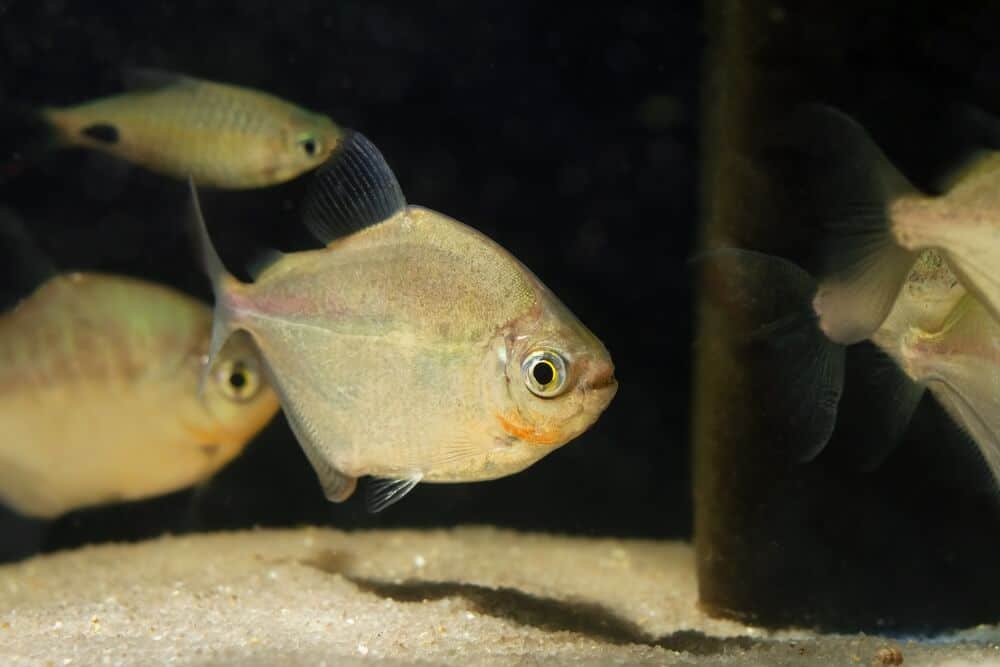
Scientific Name: Metynnis argenteus | Adult Size: 6 inches | Tank Size: 20 Gallons | Temperament: Peaceful And Fin Nipping | Temperature: 75 – 82 °F (24 – 28°C) | Water Hardness: 4-15 dGH | pH: 5.0 – 7.0 | Care: Easy | Diet: Herbivores
If you have a dark backdrop fish tank setup, then silver dollars are the perfect fish to increase its charm. These unique shaped fish are hardy, peaceful, and adapt to a wide range of water conditions. That makes things much easier on you!
Silver dollars aren’t picky at all about food – they’ll readily accept flakes, pellets, veggies, whatever you offer. Their size does mean you need at least a 55 gallon tank, but it’s worth it for their unique disc shape and playful personality.
You’ll love watching them gently swim and interact peacefully. Their shimmering silver shining body will light up your tank. But one thing to watch out for is they can be fin nippers at times. So avoid keeping them with any fish that has flowy fins like angelfish. Instead, their ideal tank mates are cory catfish, clown loaches, or cichlids.
#16. Rosy Red Minnows
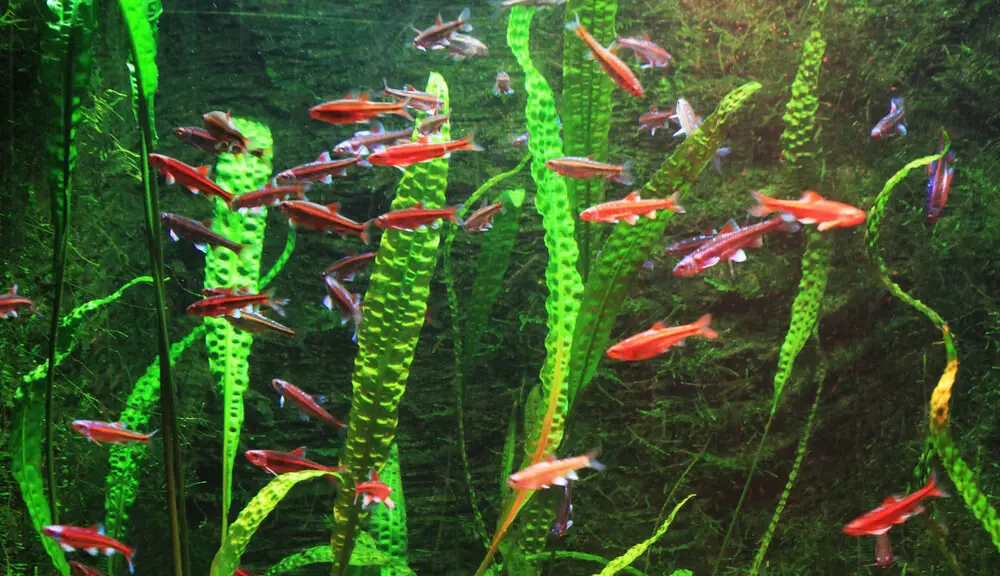
Scientific Name: Pimephales promelas | Adult Size: 2-3 inches | Tank Size: 10 Gallons | Temperament: Peaceful | Temperature: 50 – 78 °F (10 – 25.5°C) | Water Hardness: 5-18 dGH | pH: 7.0 – 8.0 | Care: Very Easy | Diet: Omnivore
You can’t go wrong with rosy red minnows for an easy, hardy fish. They tolerate a very wide range of water parameters, perfect for beginners still learning. Rosy reds aren’t fussy at all about food – basic flakes or pellets are fine.
They do well in ponds during summer too! Their small size means you can keep them in small tanks, even 10 gallons. But they truly live happily in large groups, so I recommend 20+ gallons. Rosy reds are peaceful and mix well with other calm fish.
You’ll really like their bright color hues of orange to pink. For an easy, colorful, and active schooling fish, rosy reds are a great choice!
#17. Dwarf Cichlids
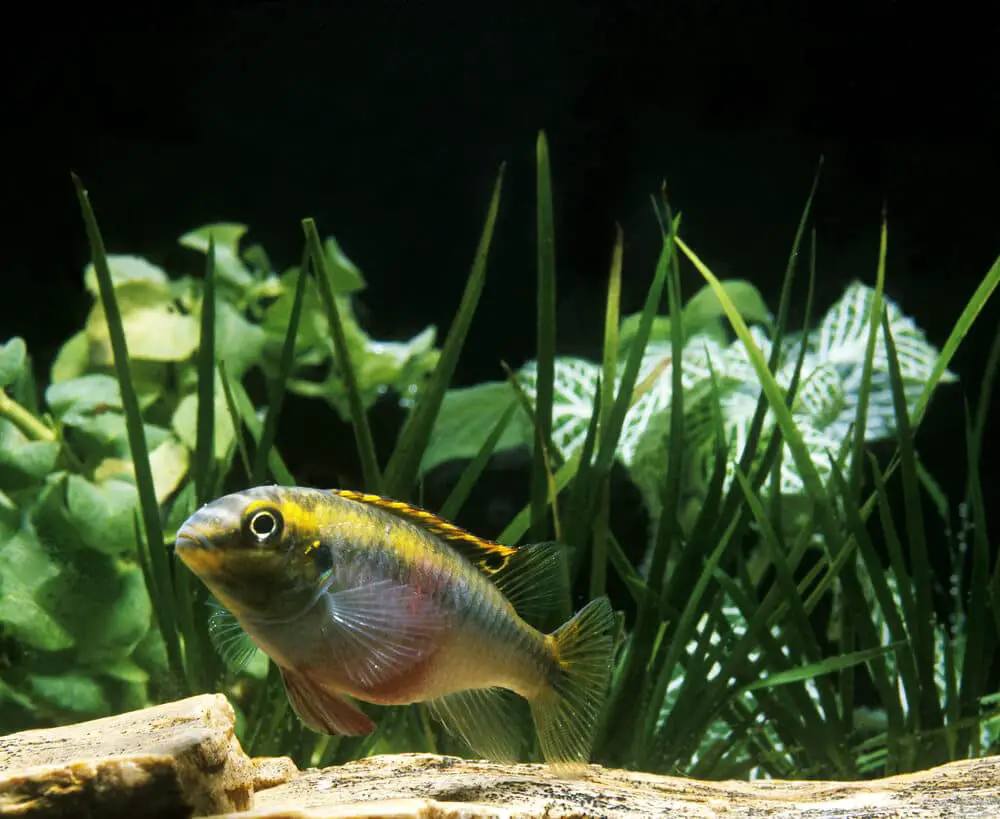
Scientific Family: Cichlidae | Adult Size: 2-3.4 inches | Tank Size: 20 Gallons | Temperament: Peaceful But Sometimes Aggressive To Protect Their Tank Space | Temperature: 75 – 85 °F (23.8 – 29.4°C) | Water Hardness: 5-15 dGH | pH: 7.8 – 8.5 | Care: Easy | Diet: Omnivore
I’m a huge fan of dwarf cichlids. Most cichlids need big fish tanks because they are aggressive about their tank space. But for dwarf cichlids won’t be a big issue.
They stay under 6 inches in size but pack tons of color and personality! Dwarf cichlids like kribensis are hardy, not too demanding, and adapt well to a range of water conditions. This makes maintenance easy for you.
A 10 gallon planted tank is sufficient, but 20 gallons is ideal. When it comes to food, they aren’t picky at all – basic flakes or pellets work great.
Dwarf cichlids prefer water on the soft, acidic side, but don’t stress if parameters vary a bit, they are very hardy. Their lovely colors and fun behaviors will quickly make them your favorite.
Only caution is to make sure you select their tank mates after thorough research because cichlids tend to be very aggressive.
#18. Clown Loach
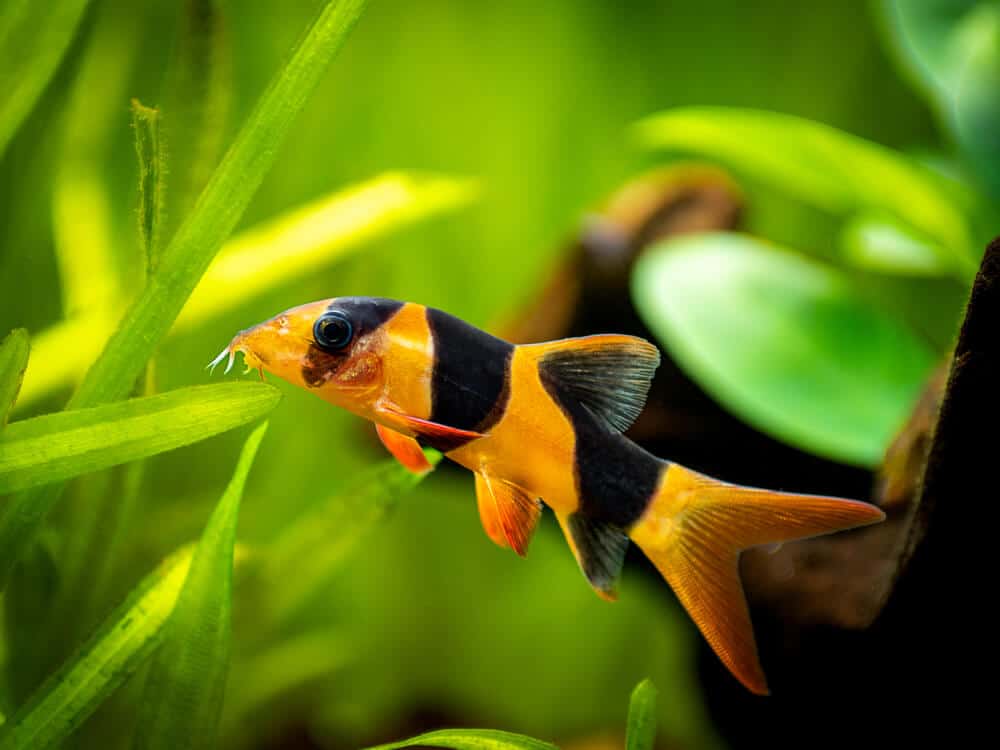
Scientific Name: Botia macracantha | Adult Size: 12 inches | Tank Size: 55 Gallons | Temperament: Peaceful And Playful | Temperature: 75 – 85 °F (24 – 29°C) | Water Hardness: 5-15 dGH | pH: 6 – 7.5 | Care: Easy | Diet: Omnivore
You can’t go wrong with clown loaches for an easy, hardy bottom dweller. They tolerate a wide range of water conditions, perfect for beginners.
I’ve kept clown loaches so I can highly recommend them especially because of their calm and playful temperament.
We had a power filter and our clown loaches used to swim and enjoy against the waterflow all day long. So if you have a big fish tank, I highly suggest having water flow in the tank either through a wavemaker or through a power filter.
Just keep in mind that they can grow up to 11-12 inches in size. So a bigger tank is preferred. But don’t worry. Clown loaches grow slowly and if you have already planned to upgrade your fish tank down the line, then it’s a good decision to have them.
You can bring a bunch of juvenile clown loaches (remember they are schooling fish so having them in groups is better.) They don’t disturb other fish and get along with most community fish.
Because they are peaceful, a 30+ gallon community tank is perfect. Clown loaches will spend lots of time resting in shaded spots. But when active, their colorful patterns and playful behavior will quickly win you over!
#19. Angelfish
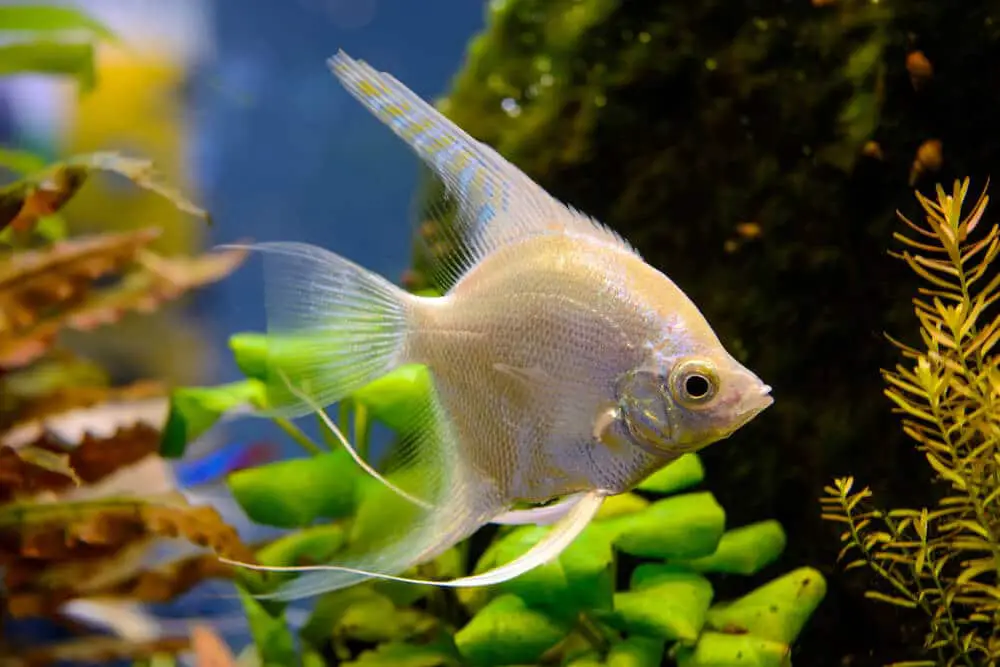
Scientific Name: Pterophyllum scalare | Adult Size: 6 inches | Tank Size: 20 Gallons | Temperament: Peaceful But Can Be Sometimes Aggressive For Tank Space Or During Breeding | Temperature: 75 – 82 °F (25 – 28°C) | Water Hardness: 4-12 dGH | pH: 6.8 – 7.0 | Care: Easy | Diet: Omnivore
Angelfish are a good choice for beginning fishkeepers because they are fairly hardy yet have impressive appearance. They need at least a 20 gallon tall tank as they can grow up to 6 inches long.
While juveniles start out small and can be kept in community tanks, adults may get aggressive toward smaller fish. Angelfish eat standard cichlid pellets and flakes. To learn more about their feeding check out this guide on how often to feed Angelfish.
They are tolerant of a variety of water conditions.
Angelfish enjoy densely planted aquariums, but they also do fine in simpler setups, making them easy to care for. Their unique shape, graceful swimming style, and bold stripes make them interesting to observe.
Just be sure not to house them with nippy fish that may damage their long fins.
What Fish Are Not Suitable For A Low-Maintenance Fish Tank
Goldfish
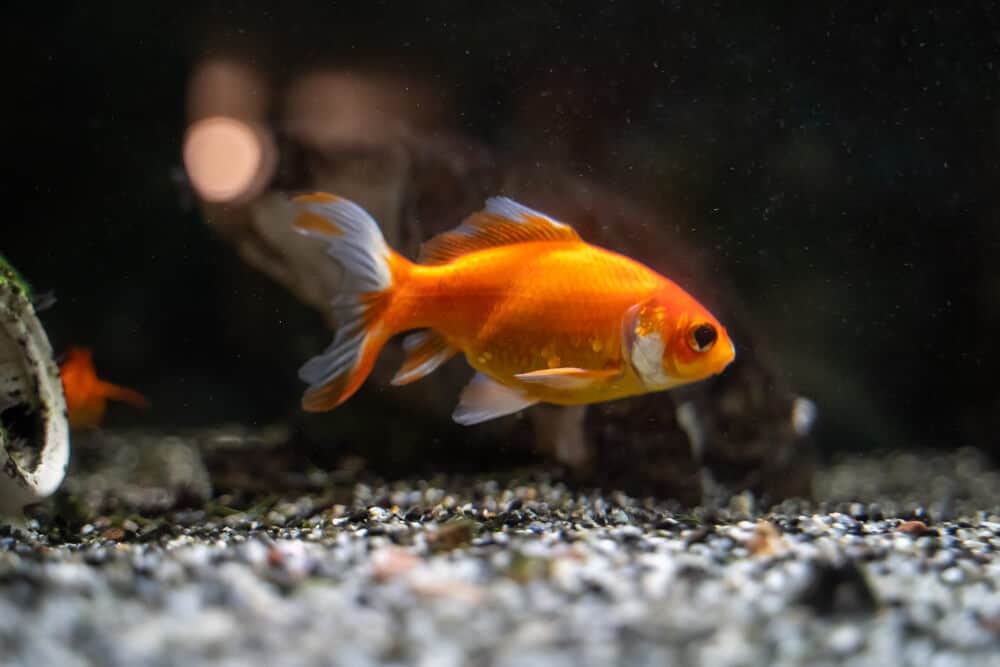
Normal Goldfish are available at a very affordable price so most beginners choose them for the tank. But the main problem is they are not very hardy.
Swim bladder disease, Fin rot and fungal infections are quite common to goldfish if they are not properly taken care of.
Plus, they produce more waste than other fish and as a result tank water becomes dirty faster. To keep up with their bioload, you’d have to do more frequent water changes which can be challenging. So, due to all these reasons, it’s best to look for other alternative fish.
See Related: Do Goldfish Need A Heater?
Discus
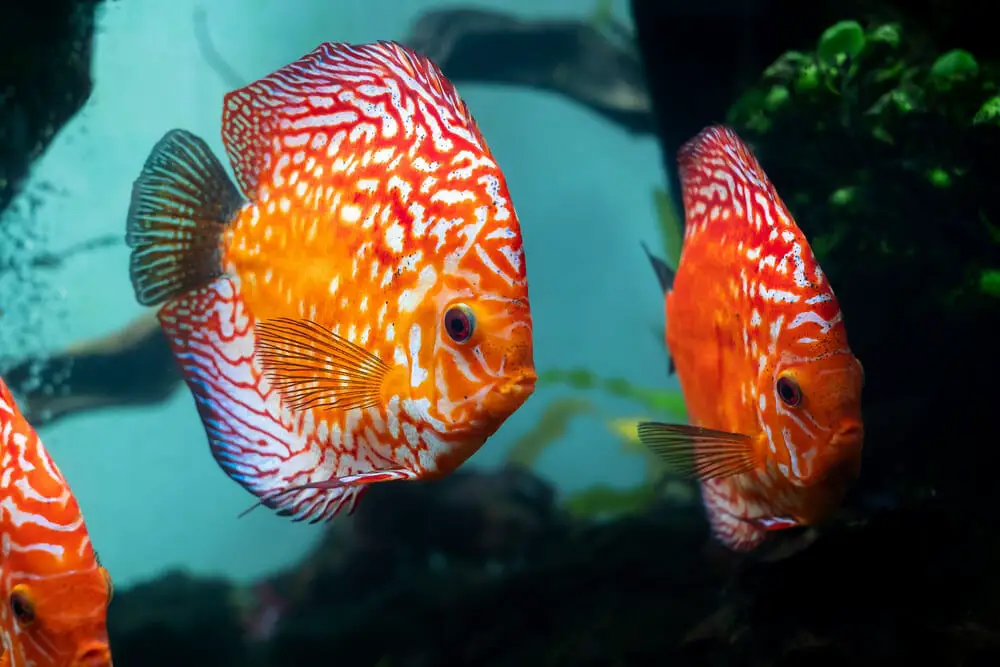
Discus fish are one of the most well-respected fish in the aquarium hobby. They are popular as the “King Of Aquariums.”
They need clean, warm, soft water to thrive, which can be challenging to provide as a new fishkeeper. Even slight changes in their environment can stress them out.
Maintaining water parameters is challenging. But other than that, they are quite peaceful and easy going. So if you have little bit experience in fishkeeping, then feel free to go with Discus. I’d say they are moderately challenging in taking care of.
But if a low-maintenance tank is your goal, then it’s better to look for other easy to care for fish I shared in this guide.
Oscars

An oscar fish might seem like an easy large centerpiece fish, but they actually need advanced care. Oscars are very messy fish that produce lots of waste, requiring heavy duty filtration and diligent tank cleaning. They also grow very large and can become aggressive, needing at least a 55 gallon tank.
Neon Tetra
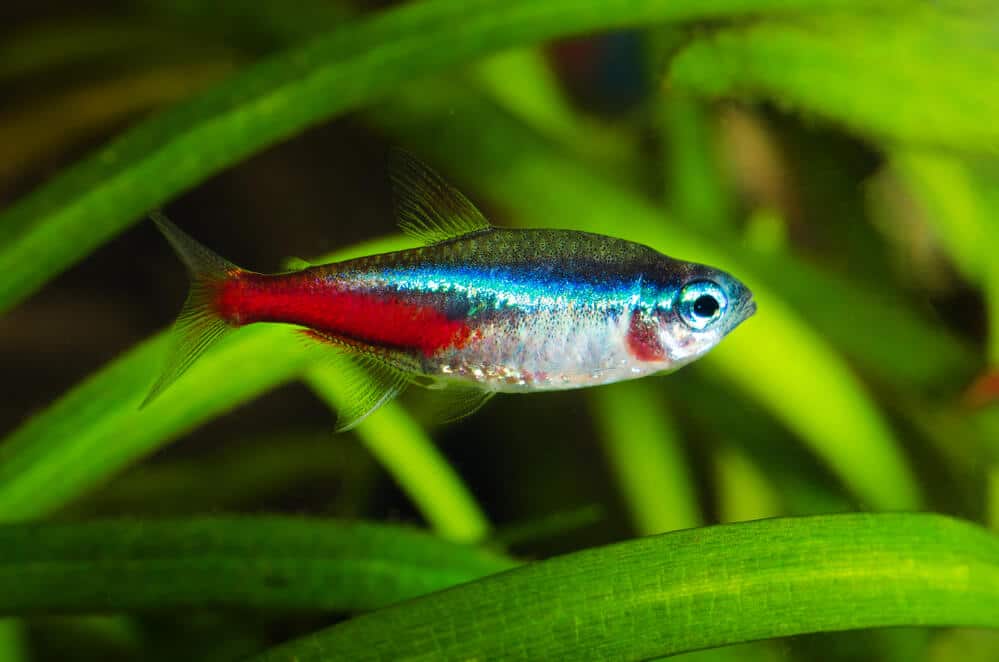
Neon tetras are small fish and don’t have any special requirements. However, the main challenge is they are very sensitive to water quality.
Even with slight changes in water parameters, they can easily fall sick and die. So it’s best to go with fish, if you’re an absolute beginner and want a low-maintenance fish tank setup.
Conclusion
Keeping an aquarium can be super fun, but it does mean you need to put in some work to keep those fish happy and healthy. If you’re just starting out, go for easy, low-maintenance fish that won’t stress you out.
Based on everything we covered, I’d say zebra danios, platies, and mollies are the top 3 easiest fish for all fishkeepers. They can handle changes in water conditions, eat basically any fish food, stay small, and get along with other fish.
Set up their tank properly, feed them a good diet, and do water changes every few weeks – that’s really all they need to live happily in the tank.
A community tank with a few of the easy fish covered here will make for a gorgeous, lively display that brings joy with little work required. It’s a great way to dip your toes into the aquarium hobby.
And be sure to follow us on Pinterest for more aquarium tips and inspiration. You can also check out our blog anytime for helpful articles related to fishkeeping.
Hi! I’m Praveen Ghoshal, the founder of eFishkeeping.com. Inspired by my Dad, I got interested in fishkeeping when I was a kid. Since then, I have been involved with this hobby. Currently, I have 3 fish tanks at our home, and I enjoy this hobby with my full family. Read more about me here.

